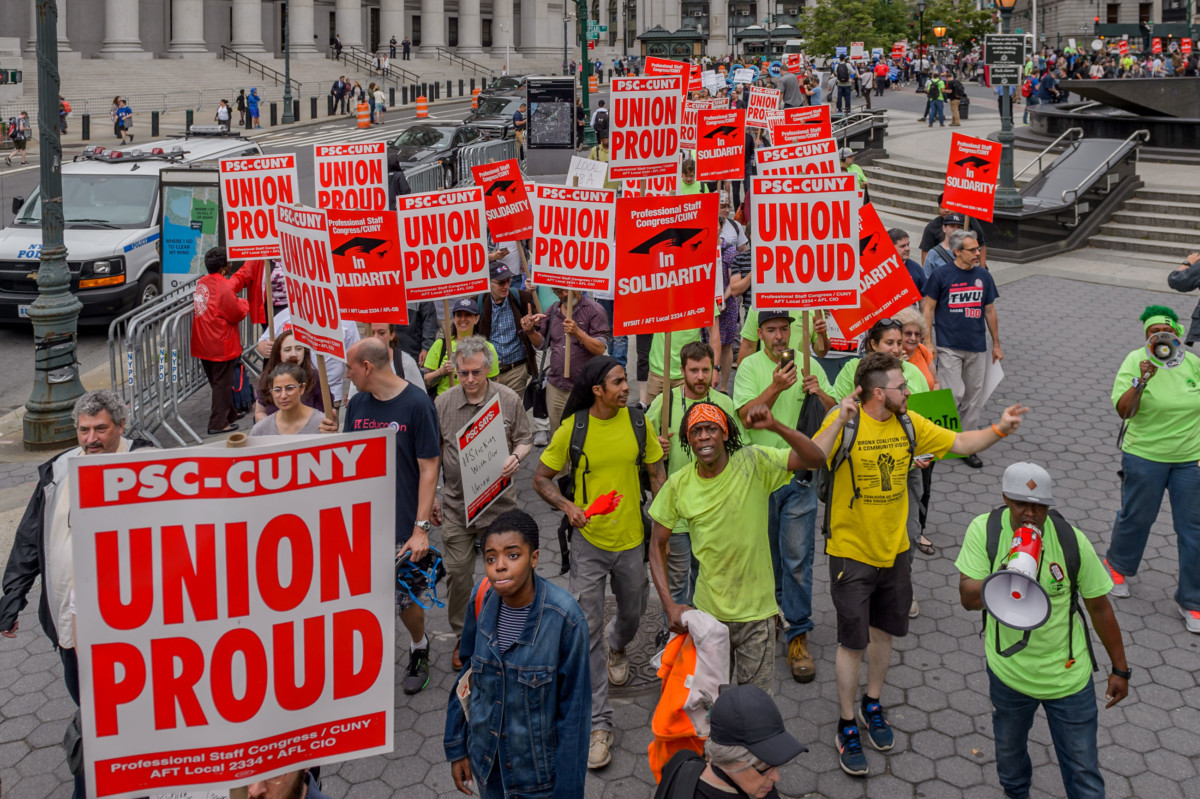Federal employees are at war with a presidential administration that’s bent on busting their unions. They rallied around the country July 25, their day in court as federal unions sue to halt three anti-union executive orders.
President Donald Trump’s push is the most antagonistic he’s ever seen under any president, said David Cann, director of bargaining for the Government Employees (AFGE). With 700,000 members scattered across 70 federal agencies, AFGE is the largest union of federal workers.
“It’s aimed at choking the union out of existence,” Cann said. “The overarching desire is to kill the union.”
AFGE, the Treasury Employees (NTEU), and other federal unions have filed suit in federal district court against the three executive orders that Trump signed on May 25, a Friday afternoon that will live in infamy.
Three Blows
One order would severely reduce due process requirements when the government wants to discipline or fire a federal worker. When employees are accused of performance problems, Trump would like to let them go after 30 days, rather than giving them the 150 days for improvement provided in some federal contracts. The president is also trying to eliminate employees’ ability to file grievances over terminations, performance appraisals, or awards.
A second executive order would drastically cut the amount of paid time that union reps are allowed to represent federal employees and to deal with federal agencies on matters that are often of mutual interest. The order would even prevent union reps from filing grievances or representing employees in grievance hearings on official time. Unions would also be prevented from using agency space and facilities. In effect it would evict union reps from offices they’ve negotiated for, and used, for decades—and from equipment such as file cabinets, phones, and computers.
The third executive order would reduce collective bargaining to a shadow of what it is under current law and practice, and would set extreme limits on timeframes and bargaining practices, placing government agencies in the driver’s seat.
The Department of Education already took this kind of unilateral approach in February—when management there did not like the pace at which bargaining was progressing, it simply implemented a contract of its own construction, shredding agreements from previous contracts on raises, overtime, scheduling, child care, and performance evaluations. On July 24, a federal labor mediator told the DOE this amounted to “bad-faith bargaining,” providing a ray of hope for the union.
Red for Feds
AFGE members held a big demonstration outside the D.C. court where the hearing took place, along with rallies in dozens of other federal sites across the country. They called it “Red for Feds,” echoing the “Red for Ed” actions by striking teachers earlier this year. Members were asked to wear red to work and to the rallies.
Members of Congress on both sides of the aisle have written to the president, asking him to rescind the executive orders, but the Trump administration has shrugged them off. Instead the Office of Personnel Management has issued guidance to agencies on how to implement the president’s directives.
Agency leaders have already started implementing the orders in at least two agencies, Housing and Urban Development and the Social Security Administration, where I work.
HUD is trying to evict federal unionists from all union offices in HUD facilities.
At SSA, agency management on July 9 barred union representatives from using agency space and equipment for almost all purposes. AFGE was told to leave its contractually provided space around the country by July 31.
Management at the agency also unilaterally reduced union official time by 88 percent and unilaterally limited what the remaining time could be used for.
“SSA followed the Trump administration’s EO ‘guidance’ with gusto, joy and clear purpose,” said Witold Skwierczynski, AFGE Council 220 president.
PATCO All Over Again
Like President Reagan’s mass firing of thousands of air traffic controllers (PATCO), these actions by the federal government could embolden other employers and state governments to go on the attack, said labor lawyer Moshe Marvit.
“After PATCO, the firing of strikers became far more prevalent,” Marvit said. “Having the president do it sends a message.”
New book from Labor Notes: Secrets of a Successful Organizer is a step-by-step guide to building power on the job. “Full of so many creative examples and powerful rank-and-file stories, it makes you want to dive right in.” Buy one today, only $15.
Matching Opportunity Extended: Please support Truthout today!
Our end-of-year fundraiser is over, but our donation matching opportunity has been extended! Today, all donations to Truthout will be matched dollar for dollar. Your one-time gift today will be matched immediately. As well, your monthly donation will be matched for the whole first year, doubling your impact.
This matching gift comes at a critical time. Trump has made it no secret that he is planning a demolition-style attack on both specific communities and democracy as a whole, beginning on his first day in office.
Help us prepare for Trump’s Day One, and have your donation matched today!
